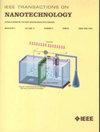Domain Wall-Magnetic Tunnel Junction Analog Content Addressable Memory Using Current and Projected Data
IF 2.1
4区 工程技术
Q3 ENGINEERING, ELECTRICAL & ELECTRONIC
引用次数: 0
Abstract
With the rise in in-memory computing architectures to reduce the compute-memory bottleneck, a new bottleneck is present between analog and digital conversion. Analog content-addressable memories (ACAM) are being recently studied for in-memory computing to efficiently convert between analog and digital signals. Magnetic memory elements such as magnetic tunnel junctions (MTJs) could be useful for ACAM due to their low read/write energy and high endurance, but MTJs are usually restricted to digital values. The spin orbit torque-driven domain wall-magnetic tunnel junction (DW-MTJ) has been recently shown to have multi-bit function. Here, an ACAM circuit is studied that uses two domain wall-magnetic tunnel junctions (DW-MTJs) as the analog storage elements. Prototype DW-MTJ data is input into the magnetic ACAM (MACAM) circuit simulation, showing ternary CAM function. Device-circuit co-design is carried out, showing that 8-10 weight bits are achievable, and that designing asymmetrical spacing of the available DW positions in the device leads to evenly spaced ACAM search bounds. Analyzing available spin orbit torque materials shows platinum provides the largest MACAM search bound while still allowing spin orbit torque domain wall motion, and that the circuit is optimized with minimized MTJ resistance, minimized spin orbit torque material resistance, and maximized tunnel magnetoresistance. These results show the feasibility of using DW-MTJs for MACAM and provide design parameters.使用电流和预测数据的域壁-磁隧道结模拟内容可寻址存储器
随着减少计算-内存瓶颈的内存计算架构的兴起,模拟和数字转换之间出现了新的瓶颈。最近正在研究用于内存计算的模拟内容可寻址存储器(ACAM),以实现模拟信号和数字信号之间的高效转换。磁性存储器元件,如磁性隧道结(MTJ),由于读/写能量低、耐用性高,可用于 ACAM,但 MTJ 通常仅限于数字值。自旋轨道转矩驱动的磁畴壁-磁隧道结(DW-MTJ)最近被证明具有多比特功能。这里研究的是一种 ACAM 电路,它使用两个域壁磁隧道结 (DW-MTJ) 作为模拟存储元件。原型 DW-MTJ 数据被输入到磁性 ACAM(MACAM)电路仿真中,显示出三元 CAM 功能。进行了器件-电路协同设计,结果表明可以实现 8-10 个权重比特,而且器件中可用 DW 位置的非对称间距设计可实现均匀间距的 ACAM 搜索边界。对可用自旋轨道扭矩材料的分析表明,铂提供了最大的 MACAM 搜索边界,同时仍允许自旋轨道扭矩域壁运动,并且电路在优化时实现了 MTJ 电阻最小化、自旋轨道扭矩材料电阻最小化和隧道磁阻最大化。这些结果表明了将 DW-MTJ 用于 MACAM 的可行性,并提供了设计参数。
本文章由计算机程序翻译,如有差异,请以英文原文为准。
求助全文
约1分钟内获得全文
求助全文
来源期刊

IEEE Transactions on Nanotechnology
工程技术-材料科学:综合
CiteScore
4.80
自引率
8.30%
发文量
74
审稿时长
8.3 months
期刊介绍:
The IEEE Transactions on Nanotechnology is devoted to the publication of manuscripts of archival value in the general area of nanotechnology, which is rapidly emerging as one of the fastest growing and most promising new technological developments for the next generation and beyond.
 求助内容:
求助内容: 应助结果提醒方式:
应助结果提醒方式:


